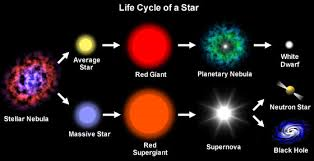Overview
A supernova (plural supernovae) occurs when a star over twice the mass of the sun explodes. It is theorized to occur near the end of the huge star’s life, before the star collapses into a black hole. According to astrophysicists, chemical elements that were heavier than hydrogen and helium were formed in nuclear reactions inside supernovae. When the star exploded, those elements were dispersed throughout the universe.
The Life Cycle of Stars
Particles of interstellar gas and dust are attracted to one another by gravitational and other forces. Most of the time, planets form from the gathered particles. However, a large enough mass, about 80 to 100 times the size of Jupiter, will start nuclear reactions on its own that produce heat and light. Hydrogen is combined in nuclear fusion to form helium, heat and light. Stars tend to last as long as they have hydrogen in their cores to fuse into helium. A star like the sun or smaller will last more than 10 billion years, while larger stars that burn hotter, will burn out their cores in millions of years.
Which Stars Explode
During the next stage of a star’s life, it cools rapidly and expands greatly, forming a red giant. When the red giant collapses, the dense stellar material can start runaway nuclear explosions. If the star is about 1 and ½ to 2 times the mass of the Sun or larger, the explosion results in a supernova. The exploding star leaves remnants behind, including white dwarfs, neutron stars, and black holes.
The Crab Nebula
A supernova can outshine an entire galaxy in a few weeks, as the star explodes, casting off light in the visible spectrum as well as radio waves, x rays, and various forms of invisible energy. Astronomers in China during the 11th century noticed a very bright star that appeared in the sky for almost two years and then faded from view. The position of the star they noticed corresponds to the Crab Nebula, which is one of the strongest sources of X rays, gamma rays, and pulsars in the galaxy. There have been other remnants of stellar explosions in the Milky Way, as well as other galaxies outside our own.
The Heaviest Elements from Exploding Stars
The runaway nuclear reactions that are produced from supernovae result in the heavier elements that occur in the universe. Theories of nucleosynthesis that start with high pressures, temperatures, and other conditions within exploding stars are well-established through stellar astrophysics. Many scientists think that life on Earth would not be possible if it weren’t for heavier elements from exploding stars.
Interested in science tutoring services? Learn more about how we are assisting thousands of students each academic year.
SchoolTutoring Academy is the premier educational services company for K-12 and college students. We offer tutoring programs for students in K-12, AP classes, and college. To learn more about how we help parents and students in Mountain Home, ID: visit: Tutoring in Mountain Home, ID




